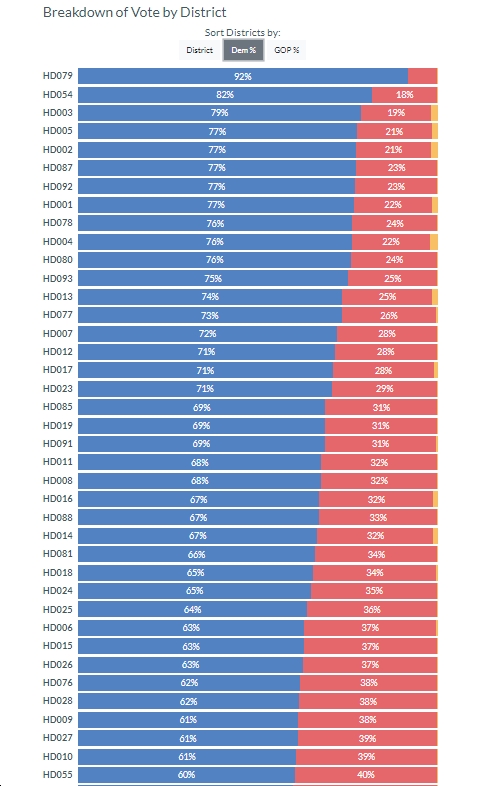I was chatting the other day with a smart Virginia Democratic politico about what the key districts were for this November, and I thought it would be helpful to lay it out in written form. So yesterday I posted about how Dems can hold/expand their State Senate majority, based on this analysis by VPAP (“Mapping Midterm Results by State Districts”).
Today, let’s turn to the House of Delegates, where Democrats currently have 48 seats out of 100, down from 55 seats prior to the 2021 elections. Of course, due to redistricting, all the districts will look different – some significantly so – in the June primaries and November general election. Overall, though, according to VPAP’s analysis, Democrats start off with 39 strong Democratic seats, 11 that lean Democratic and 10 tossups. If Democrats were to win all of those, they’d end up at 60 House of Delegates seats, up from 48 now and 55 prior to the 2021 elections. Or, much more likely, if Democrats win the 39 strong and 11 lean Democratic seats, that would get them to 50, up two seats and in some sort of power-sharing arrangement with Republicans. One more beyond that would get Dems to a 51-49 majority or higher…which would be very nice, and also is very doable – so let’s do it!
With that, here are the key House of Delegates districts to focus on this November:
- First, Democrats need to “hold serve” by winning everything above 55% Democratic performance (note: of course, that’s based on the 2022 midterm results, which obviously might not reflect turnout in November 2023). This would get Democrats to 46 House of Delegates seats.
- Next, win HD84, a 55%-45% Dem performance district based on 2022 midterm results (Democratic Del. Nadarius Clark or Democrat Michele Joyce vs. Republican Rod Thompson or Republican Michael Dillender), which would get Democrats to 47 House of Delegates seats.
- Then, win HD65, a 54%-45% Dem performance district based on 2022 midterm results (Democratic former Del. Joshua Cole vs. Republican Michael Kasey or Republican Lee Peters, III), which would get Democrats to 48 House of Delegates seats, which is exactly where they are now.
- Next, win HD58 (Democratic Del. Rodney Willett vs. Republican Riley Shaia) and HD97 (Democrat Michael Feggans vs. Republican Del. Karen Greenhalgh), both 53% Dem performance districts based on 2022 midterm results, which would get Democrats to 50 seats and some sort of power-sharing arrangement with Republicans. (Note: Del. Willett is a strong incumbent and arguably should be in or just above step #3, especially since Willett’s Republican opponent appears to be extreme – and thus very beatable. Thus, Willett could be the 48th Democratic House of Delegates seat, with Joshua Cole the 49th.)
- For a narrow majority of 51 or 52 seats, win HD21 (Democrat Joshua Thomas vs. Republican Joshua Joseph Quill or Republican John Stirrup) and/or HD82 (Democrat Kimberly Pope Adams or Democrat Victor McKenzie or Democrat Branden Riley vs. Republican Del. Kim Taylor), both 51%-49% Dem districts based on 2022 midterm results.
- For some cushion (or “icing on the cake,” whichever metaphor you prefer), Democrats need to win one or both 50% Dem performance districts based on 2022 midterm results – HD57 (Democrat Susanna Gibson or Democrat Bob Shippee vs. Republican David Owen) and/or HD89 (Democrat Karen Lynette Jenkins vs. Republican Don Carey or Republican Baxter Ennis or Republican Jason Wooldridge), which would get them potentially as high as 54 seats up as many as six from where they are now.
- And finally, just for fun, if we’re talking about a “blue wave” election, Dems might even win some of the districts where they didn’t quite get to 50% in 2022, such as HD66 (Democrat Mark Joseph Lux vs. Republican Del. Bobby Orrock), HD75 (Republican Del. Carrie Coyner doesn’t have a Democratic challenger yet) and HD22 (Democrat Travis Nembhard vs. Republican Ian Lovejoy), all of which are at 49%-51% based on 2022 midterm results – and maybe even get higher than the 55 House of Delegates seats Dems held prior to the 2021 elections. We can dream, anyway…lol.
So there we have it – winning a Democratic House of Delegates majority in five doable steps, and winning an even bigger majority than that in a couple tougher steps after that. Is everyone ready for the battle this November? If not, get ready, because it’s coming, and the stakes are every high (e.g., keeping Glenn Youngkin from having a governing “trifecta” and trashing much if not all of the progress we’ve made in Virginia the past few years)!




 Sign up for the Blue Virginia weekly newsletter
Sign up for the Blue Virginia weekly newsletter








![Sen. Mark Warner: “The best time to [pass aid to Ukraine] would have been months ago. The second best time is right now.”](https://bluevirginia.us/wp-content/uploads/2023/02/warner0207-100x75.jpg)